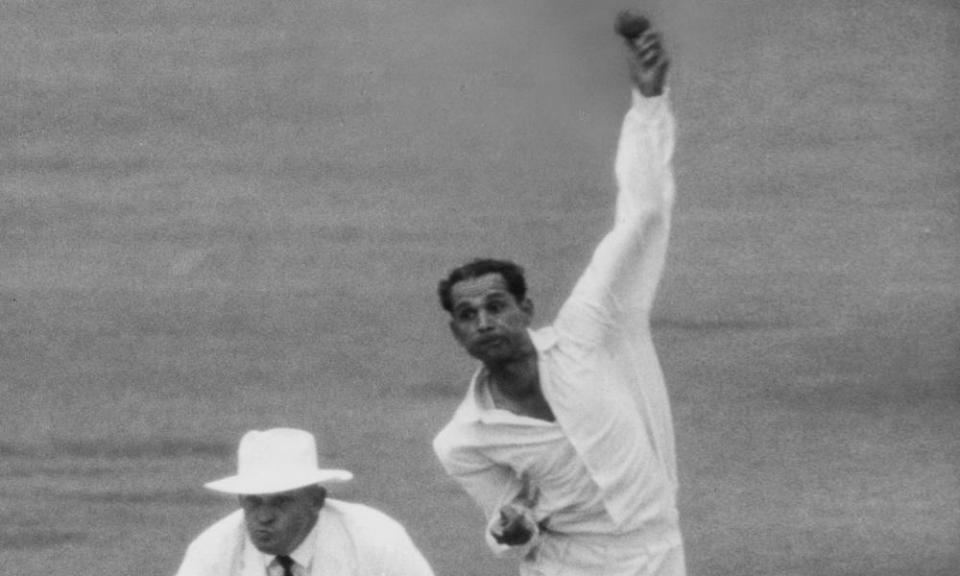Nadkarni’s maiden epic was cricket at its dullest but boredom is part of pleasure

Fred Fane was surprised to find he had died but there it was in print in the 1956 Wisden, a 350-word eulogy about life and times playing for England and Essex. Five years later, when Fane really did die, they only gave him 230, and a good chunk were by way of explanation: “Owing to a similarity of initials, Wisden reported his death when he was 79. The man concerned was Francis L. Fane, his cousin.” Some people, like Fane, get to read their obituaries, and some people don’t need to because they already know what they’re going to say anyway. RG “Bapu” Nadkarni, who died in Mumbai last week, aged 86, was one of the second lot.
Related: Dom Sibley’s blunting approach hints a long line of openers has an heir | Andy Bull
Nadkarni was, as almost every one of his obituarists noted, a parsimonious left-handed spinner. He played 41 matches for India through the 1950s and ’60s, and 191 first-class games for Bombay and Maharashtra. He scored an unbeaten century to save a Test against England, took 11 wickets in a match against Australia, worked as the national team’s assistant manager, and was a mentor to Sunil Gavaskar. But each of these achievements was eclipsed by another, his world-record spell of 21.5 consecutive maiden overs – 131 balls without conceding so much as a single run. It was Nadkarni’s 99.94, his 501, his 19 for 90. Sachin Tendulkar said last week that he grew up hearing about the feat.
It was in Chennai in 1964, the first Test against England. It was, Nadkarni said, a peculiar match, a fight in which neither side wanted to throw a punch. India batted first and declared on 457 for seven. By the start of the third morning, England were 63 for two and, worse, four of the team were suffering from food poisoning. Micky Stewart and Jim Parks had it so bad they were laid up in bed with fever. They kept a car waiting outside in case they needed to be rushed to the ground to bat. England had to stall for time till they were better, so their two doughty batsmen, Brian Bolus and Ken Barrington, decided to start blocking. And blocking. And blocking.
And Nadkarni just kept bowling. And bowling. And bowling.
Nadkarni had learned his cricket in Bombay, a hard school. “Bombay cricket at that time was so disciplined,” he said later. “The basic principle was to be accurate to the point of perfection.” He’d drop a coin on a length outside off-stump, sketch a chalk circle around it, and spend hours bowling at the spot. “His favourite term from where we all learned from was ‘chhodo mat’,” Gavaskar said last week. It means hang in there. “Chhodo mat. You are playing for India. That thing we learned from him.”
In England, they were trying one-day cricket as a tonic. Fifty years later, they’re still coming up with new cures
The Chennai Test became a blinking contest. After lunch there were 12 maiden overs in a row. “Neither batsman attempted to score any but the most obvious runs,” wrote Henry Blofeld in the Guardian. “A number of half volleys were pushed back defensively.” Nadkarni gave up a single soon after he’d come on, and after that, it was maiden, maiden, maiden, maiden, maiden, maiden, maiden, maiden, maiden, maiden, maiden, maiden, maiden, maiden, maiden, maiden, maiden, maiden, maiden, maiden, maiden, as monotonous as the tick tock of the classroom clock.
Finally, just after three in the afternoon, Nadkarni was five balls through what would have been his 22nd maiden when the man at mid-on misfielded and the batsmen stole a single. And, just like that, Nadkarni’s captain took him out of the attack, “as if”, the Times noted, he was all of a sudden judged “altogether too expensive” to carry on. Nadkarni was still annoyed about it 50 years later. He had bowled 131 consecutive dot balls. It is one of those records that will likely stand as long as they’re playing the game. South Africa’s Hugh Tayfield once bowled 137 in a row but they were spread across two innings.
Related: The Spin | The Hundred will be hangover to cricket year that took the biscuit
The Chennai Test was a draw. So were nine of the 10 other games they played on that tour, including all the other four Tests. It was one of the most stultifying boring series ever played and yet it pulled in a total of over a million spectators. “Day after day,” Wisden reported, “the Test grounds, who capacity varied between 30,000 and 45,000, were packed. Financially the tour was a rousing success, though the nature of the play inflicted sore wounds on the game of cricket.” Back in England, they were already trying county one-day cricket as a tonic, soon enough they’d start playing it internationally too. Fifty years later, they’re still coming up with new cures.
Because there is no getting around it, Nadkarni’s duel with Barrington and Bolus must have been one of the most singularly dull passages of sport anyone was ever asked to pay for the privilege of watching, a psychological Sahara of a day out at the cricket. A strange entertainment, this, and not one they’re interested in showing on free-to-air TV in the 21st century. But Nadkarni is still remembered for it, celebrated for it, all these years later, because as everyone who loves Test cricket knows, the boredom’s part of the pleasure, what would the good bits be worth without all those lovely lulls when the game drifts like dust in a sunbeam? There are days of play we euphemistically describe “for the purists”, some vanishing band of diehards, a dwindling audience of Bapu Nadkarni fans.

 Yahoo News
Yahoo News 